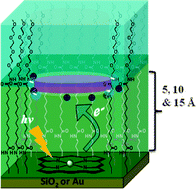Molecular cavities constructed within rigid monolayers of yoctolitre (1 yL = 10−24 L) volume, the so-called yoctowells, are novel surface-engineered systems capable of studying the separation, containment and manipulation of individual molecules. The properties of the yoctowell can be fine-tuned by the nature of the monolayer, or by post-functionalisation leading to amongst others, the exploitation of electrostatic effects. The derivatisation of the cavities implies they can be used as a means of discriminating between substrates with application in molecular sorting of two or more molecular entities in solid devices, or become useful as an appropriate model with which to study molecular interactions. Of prime importance to all the cases described herein is the use of porphyrins as an optical readout (absorption, emission) of the recognition event. In this tutorial review, we describe the development of yoctowell chemistry and comment on future advances in this technology in light of other literature approaches.

You have access to this article
 Please wait while we load your content...
Something went wrong. Try again?
Please wait while we load your content...
Something went wrong. Try again?


 Please wait while we load your content...
Please wait while we load your content...